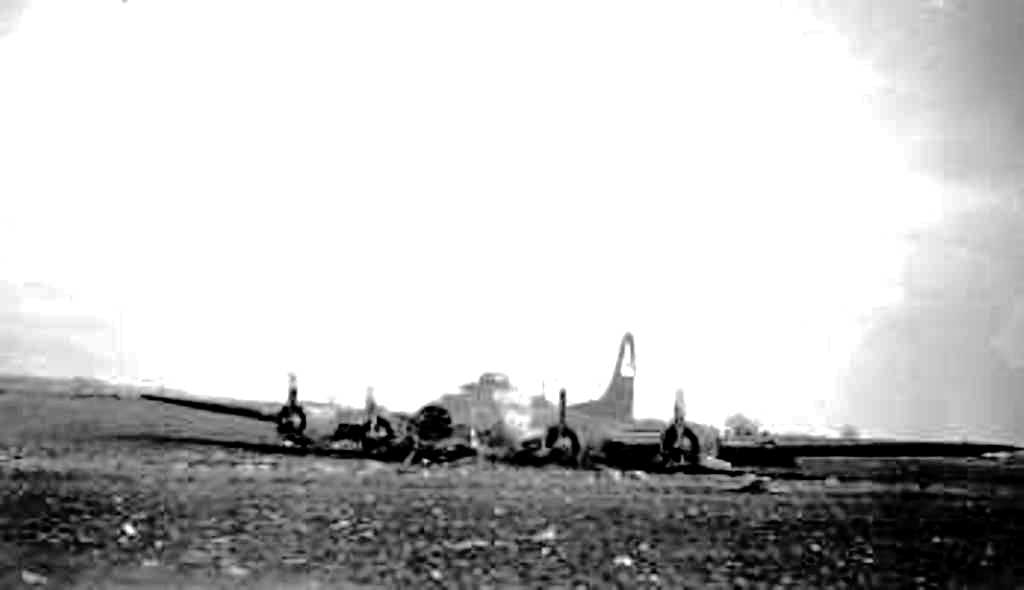
The crash landing of Lackin'Shackin' B 17G in April 1944
In the morning of April 11th, 1944 approximately 900 USAAF heavy bombers left
England to bomb Rostock, Stettin, Poznan and other towns in Germany.
Nine of them landed or crash-landed in the province of Skåne in southern Sweden.
Two of them received fired from Swedish anti-aircrafts guns.
One of these two was the B 17G number 42-39929 "Lackin'Shackin'"
of the 8th Air Force, 8th Bomb Command, 81st Bomb Div, 91st Bomb Group,
401st Squadron, based at Bassingbourn, North of London. It ended up in a field
outside Vollsjö in southern Sweden.
The last landing of Lackin'Shackin'. The picture was taken the day after the landing by the author, then twelwe years of age.
The crew, age 19 to 24
Pilot: 1.lt Frank C Ammann Copilot: Lt Frank Logan Butler
Navigator: Lt Harold A Levin Bombardier: Lt Patrick H McNulty
Top Turret Gunner: Sgt John L A Corazza Radio: Sgt Frank Bynon
Waist Gunner: Sgt Howard Hornick Tail Gunner: Sgt Frank Martin
Ball Turret Gunner: Sgt Irvin F Kennedy Photographer: Philip Heacox, 8th
Air Force. (replaced one of the gunners who had taken ill)
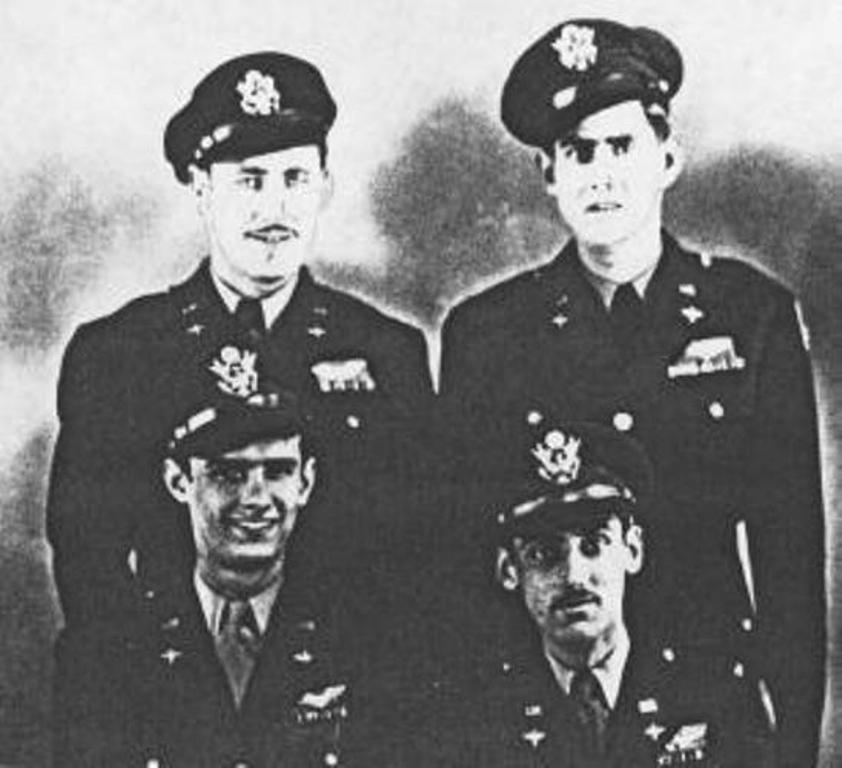
Top: 1:st Lt Frank Ammann, Lt Patric McNulty.
Bottom: Lt Frank Butler Jr, Lt Harold Levin.
This was the 21th mission of the crew.
The story of the last mission
[Translators note:
This part is a summary in English of a translation to Swedish of a letter from the
navigator Harold Levin to Ingmar Nilsson in Sweden. The letter was written in
1996.
It´s not good practise to publish this since a lot of information have been lost through the two translations, but i don´t have access to the original letters.]
Our target was Cottbus at river Oder, 100 miles South East of Berlin.
When we turned South East to go to Initial Point our formattion was attacked by 400 German fighters. One of them hit our number three engine and we were forced out of the formation.
We managed to follow our squadron, but at a much lower altitude. When we flew over Stettin German flak killed our number one engine. The pilot then asked me for a route to Sweden. Our altitude at the target was 25000ft, at Stettin 10000ft and when we reached Sweden
4000 ft. Over the Baltic sea we lost the number four engine.
At that point we threw his camera and 2.5 hours of recording overboard. Our flight over the Baltic sea was cloudy but when the sky cleared up we were over dry land. Lt Ammann asked me where we were and I said Sweden. Lt Amman said "Prepare for crash landing" but at that instance we received AA-fire and lt Amman ordered us to jump. I ended up in a pine tree while the others landed in the fields, except for lt Amman whos parachute had opened inside the cockpit, which forced him to land the aircraft. The only misfortune was that our Copilot Frank Butler broke a bone in one foot.
The others did not believe that we were in Sweden since we had been fired at.What had happened was that the AA-battery had been engaged by a German fighter and killed it. We flew in a couple of minutes later. We were taken to a police station and interrogated by an army colonel while the German plane was burning outside. We were transported to the city of Malmö and then sent by train to the town of Falun in the province of Dalarna.
[Left out the story about lt Levin and the other crew members time interned in Sweden]
On October 17 1944 we were realized and sent back to England.
Kindest Regards
Harold Levin

The route of Lackin' Shackin' on April 11 1944
The gunner in the belly turret, Irvin Kennedy, says that he landed at a farm and met a 10 years old boy. The farmer invited him for lunch and Kennedy gave him his parachute. The farmer said that his wife and daughter could use the excellent silk for dresses.
After lunch a policeman arrived to the farm and brought him and the parachute along. The policeman had already picked up the tail gunner Frank Martin who had landed on the roof of a church but slid down without any harm. Kennedy and Martin were then transported to Sövde by military personnel.
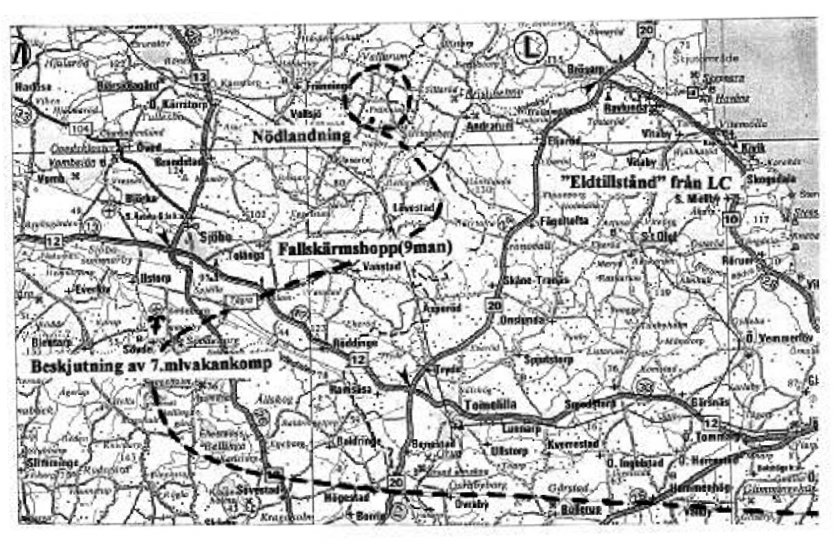
The approximate route over Sweden
The crash landing
Eye-Witness Malte Olofsson:
On April 11 1944, at about lunch time, I was having a chat with two of my friends. We were standing by the road. Suddenly there was a big airplane right above us at low altitude. We noticed that one or two engines were out.
The plane made a turn to the North and then to the East and then came back from the same direction as the first time. It descended rapidly and made a violent belly landing 200 yards from where we were standing. It came to rest on the fields of the farm "Näsby Boställe" in the parish of Näsby, just some 50 yards from the parish border. At the landing there was a cloud of dirt, grovel and stones all around the plane, because it went right throw a stone wall.
We ran towards the aircraft and found that the pilot had left it through a hatch behind the right wing. The pilot had ran to the nearest building, the home of Ove Sjörén, some 80 yards away. When we arrived the pilot returned and were about to reenter the plane. The ground was covered with petrol and machine gun ammunition.
As I was a member of the Home Guard it was my duty to stop him. He then turned towards the small crowd of curious farmers that had already turned up. He waved his arms as if he tried to make them back off. At the same time he pulled out a lighter, probably as he was ordered to destroy the plane rather than let it fall into enemy hands.I grabbed his arms and said "Sverige, Sweden", he then looked relieved and took my hand. He made no more attempts to put the plane on fire.
As more and more civilians gathred around the crash site I realised that i had to go home and get my uniform and my rifle to be able to keep them of. When I returned the Home Guard from Klasaröd had already arrived.
The pilot was searched and taken to Näsby Boställe and i was appointed to guard him. As it was time for lunch he was treated with egg and pork and fresh milk, which he seemed to enjoy. The vicar, who knew English, arrived and had a long conversation with Lt Ammann befor he was picked up by the 3rd Motorized Battalion and taken to Sövde for interragation.
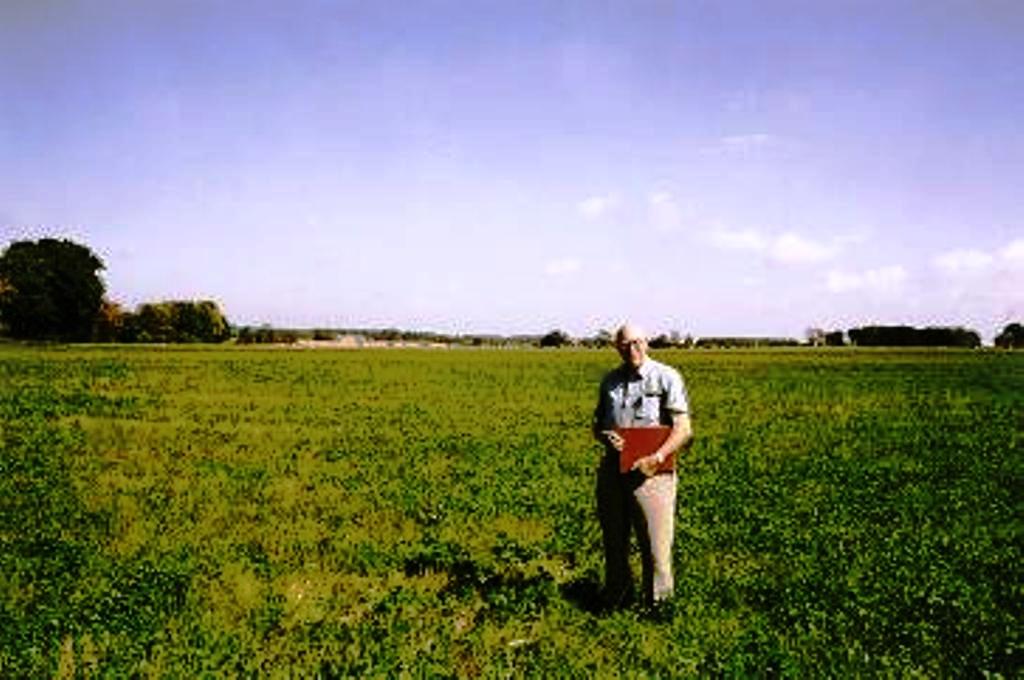
Malte Olofsson on the same spot as the B17 belly landed 58 years ago.
He still lives on the same farm, just some 200 yards away
.
Ove Sjörén informs us that his mother was alone in the house on the 11 of April
She heard a loud roar from an aircraft passing right over the building and a short while later the sound of big crash just outside the house. She was very frightened and locked the front door. She then went out the back door and walked towards the crashed airplane. Just behind the backyard she met an airmen who yelled something that sounded like "Sverige". She nodded at him, he then kneeled and it looked like he prayed.
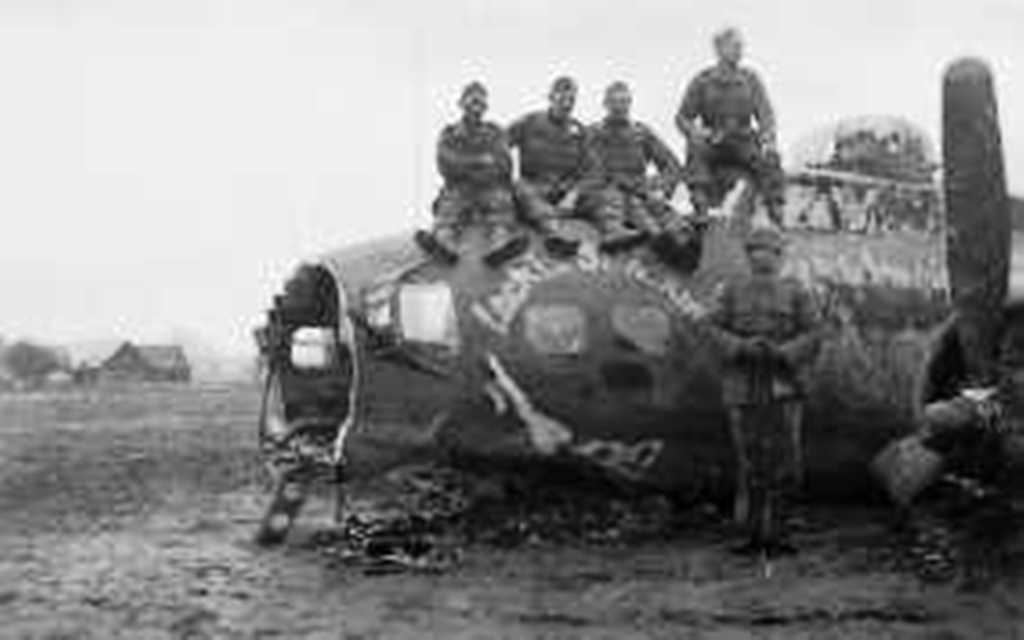
Swedish soldiers guarding the remains of Lackin'Shackin'
The Lackin'Shackin' was damaged beyound the repair. After a few days the landing gear was lowered and then the plane towed to a nearby meadow. It was then dismounted and sold for scrap.
HEMLIG
jäml. kung. 1938 nr 757
Attending:Maj E.Gabrielsson-President
Lt P.E.Persson- Secretary
Capt Rosberg- CO of the 81 st Rifle Company
Sgt Jacobsson- Fire commander at point 5B at the airfield at Sövde
Capt Rydén- CO of the 7th Motorized AA-company
7.motbrig Avd VI nr H:28, 11/4 1944
This hearing is prompted by the action of sgt Jacobsson at 1255 April 11. As Fire Commander at a 40mm AA-gun at point 5B at airfield number 2 (Söfde), of the 7th motorized AA- company, he fired at an American B17.
Sgt Jacobssen states that:
At 1200 a German aircraft cirled the airfield
He tried to find out if he had permission to fire.
The phone line was busy so he could not get an answer.
A short while later the German plane was shot down by the 40 mm gun at a point 1a and crashed at Sövde.
At 1213 the All Clear Signal sounded.
At 1225 a new Alarm Signal was given.
He received a message from the Local Anti-Aircraft Command (LC) that the alien airplane encountered at Simrishamn, heading West, was a legitimate target.
At 1250 a B17 was spotted South of the posting.
At 1255 25 rounds was fired as a warning.
Since the plane continued on the same course, heading North-East, he ordered Fire For Effect.
The distance was then about 800 yards.
Only two rounds were fired before smoke emerged from the plande and he ordered Cease Fire.
The next instant the crew parachuted.
The plane disappeared, heading East
He was well aware of the regulations.
The previous fire from the gun at point 1a and the report from LC made him order Fire.
Capt Rosbergs states that:
When gun 5b fired he was in Sövde where the German plane had crashed.
He received reports that parachutists had landed in Tågra.
He then went to Tågra.
Lt H. Levin had been capturedby a member of the Home Guard.
He brought the prisoner to Sövde for interrogation.
Ten parachutists from the crash landed B17 had been captured by the 3rd Motorized battalion.
The plane had crashed 6 km East Vollsjö.
The plane was badly damaged.
Capt Rydén states that:
According to the regulations for AA-units deployed at air fields the unit should not have opened fire.
However the message from LC had been vague.
Therefor the Fire Commander had been mislead.
The fire of the nearby gun had added to the confusion.
That Sgt Jacobsson is a reliable man who did his best. The protocoll was approved by the attenders.
Nothing else was spoken. E. Gabrielsson CO III.mbat, Major
On April 12 the CO of the 7th Motorized Brigade, V. Tamm, sent a classified PM to the Anti Aircraft Command.
Since the Fire Commander had good reasons for his actions, I will take no further action on this matter.
V.Tamm CO 7. Brigade Folke Francke.
Sidenote: Lt Ammann later played the first violin in the New Jersey Symphony Orchestra. He died in Florida in 1973. Several members of the crew are still alive.
Evert Persson
Born in Vallarum
Articel from December 2002
Ref:Oral :Malte Olofsson, Frenninge
Ove Sjörén, Vallarum
Gösta Gillander, Skeglinge
WrittenIngmar Nilsson, Hässleholm (notes and translations of letters from crew members
Malte Olofsson, Frenninge (notes)
Tyko Ohlsson, Järrestad (notes)
Protocols from the War Archive, Stockholm.(thanks to Hans Fredriksson, Ystad)
Översättning: Mats Persson / Translation: Mats Persson
